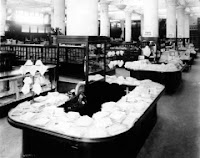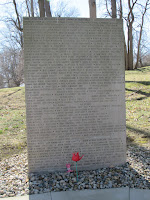Welcome to another Grave Spotlight of the Month. This time we are taking a look at the life of Lyman Skinner Ayres, founder of the fabulous L.S. Ayres department store.
Lyman Skinner Ayres was born on September 4, 1824 in Oswego, New York to parents Thomas Floyd Ayres (?-?) and Marian Jones Ayres (?-?). He had five siblings, though the names of those are not known.
His parents were owners of a farm in Oswego, New York, but Lyman disliked this career and left home in his teen years to take on the life of a peddler, eventually establishing a general store in Chardon, Ohio with partner John Murray in 1843. He owned and operated this store for 15 years along with a dry goods store in New York for 7 years.
During this time, he married for the first time to Almira G. Harned/Hamel Ayres (1829-1857) on December 12, 1851 in Geauga, Ohio. Unfortunately, she passed from consumption on April 28, 1857 on Montville, Ohio. She is buried in the Ayres Cemetery in Montville, Ohio, her heading being located behind the old schoolhouse in the woods. They had no children from their union.
His second wife, who would eventually bear him three children and move with him to Indianapolis, was Maria Helen Murray Ayres (1837-1911), the sister of his former business partner's sister. They were married in 1862. Their children were Frederick/Frederic Murray Ayres (1872-1940), Katherine Ayres Smitheram (1880-1949) and Robert Ayres (died in infancy). They also adopted a child named Emma Murray, who was their niece, when she was just an infant.
In 1864, Lyman sold his interest in the general store in Chardon, Ohio and moved to Geneva, New York, where he started his new business with partner James G. Thomas. This new venture was called Ayres and Thomas. This last until 1872, when he sold his interest and purchased controlling interest in a leading dry goods store called the Trade Palace located on 26 West Washington Street in Indianapolis in "Ray's Stone Front Building". This was in partnership with N.R. Smith and the business was renamed N.R. Smith and Ayres. His wife and family joined him in Indianapolis just two years later, right before his full success was recognized.
 |
| Indiana Historical Society |
the like. There was at one time, even a floor with fabric and millinery.
Room was a formal setting that catered to the female shopper. Several models would roam the gathering spot, showing off the current fashions available for purchase. The menu boasted consistent fare such as chicken pot pie, chicken velvet soup and special desserts for the children. The Tea Room was eventually re-created in the Indianapolis State Museum and is open seasonally.
road. On the night before Thanksgiving 1947, a three foot tall bronze cherub appeared on top of the clock. This stayed in place until Christmas, starting a tradition that lasted for years. They had elaborate Christmas window displays that people would travel to see. There even added a Santa's Workshop at one point.
Things seemed great for the L.S. Ayres Company until the changing position of shoppers in the late 1970s and early 1980s. L.S. Ayres started to struggle in the economy. The stores that they had opened in many locations in the American Midwest started to see a decline in sales and some had to close, being sold off to other companies such as JC Penney. This change included the budget basement in the flagship location. Needs changed and people began shopping at the separate budget store, Ayr-Way. (I remember shopping at Ayr-Way when I was a kid! Ayr-Way later became Target in many locations.)
The company was acquired in 1986 by the May Company. This was around the time that there were some serious discussions within the upper echelons of the company. Stores in Cincinnati were closed as well as stores in Louisville. Indianapolis was working on a new mall location downtown called Circle Centre Mall. This new mall was meant to be a destination mall with several levels, underground parking and lots of restaurants. Unfortunately, it was decided that the mall would not include the flagship location. And it was announced on October 25, 1991, that the flagship store would be closing. That same year, Ayres Company merged with Famous-Barr, a May division location in Missouri. In 1994, they were acquired by Federated Department Stores and were turned into Macy's.
It was the end of an era. The end of the elegance of shopping and the experience of a destination store.
My grandmother shopped at the original store in Indianapolis. She bought her fabric there for making my mom's dance costumes and special occasion outfits. She ate at the Tea Room. She took my mom and my uncle to see the displays. I never got to go the original store. I never got to see the displays or the magnificence of the 8 stories. I did, however, work at the Bloomington location for a few years when they were taken over by Famous-Barr. I remember how strange it was because as L.S. Ayres, we still did the huge Christmas displays and set up the entire upstairs for the holiday. We decorated the downstairs, especially the entrance with huge trees and lights and garlands. And that all ended when it became Famous Barr. I don't know if that was a thing on their part or just the shopping climate.
Whatever the reasons, the loss of L.S. Ayres and Company was felt strongly. The shopping experience was forever changed.
Rest In Peace, Lyman S. Ayres. And know that you are not forgotten. And your store will live on forever in our hearts and memories.
~~~~
RESOURCES:
Wikipedia - Lyman S. Ayres
Encyclopedia of Indianapolis - Lyman S. Ayres
Lost Indiana - Lyman A. Ayers
Indy Star - Remembering Ayres
Wikipedia - L.S. Ayres
Indy Today - The tale of the clock and the cherub














